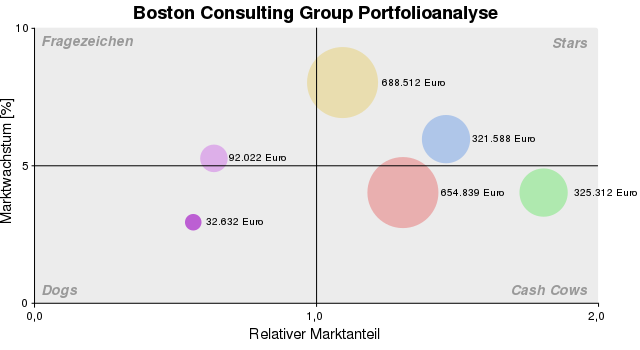Market growth
Market growth ( english market growth ) is in economics the absolute or relative increase in market volume in a particular market within a fixed period .
General
Market growth is a positive market development that leads to an increasing market size . The market growth (increase in sales in the overall market), the market volume (total sales in the market) and the market potential (the possible sales) can provide market participants with information about the expected intensity of competition . Because in a growing market there are more opportunities for expansion than in stagnant markets, because demand increases and a predatory competition based on price(Price competition) is rather unlikely. That is why the intensity of competition is lower in growing markets than in stagnating ones.
The relative market growth plays an important role in the BCG matrix , because it and the relative market share determine the classification of products / services as "stars" (market growth and market share high), "question marks" ( English question mark ; market growth high, market share low), cash cows (market growth low, market share high) or “poor dogs” ( English poor dog ; market growth and market share low).
detection
The relative market growth is determined by the growth rate as the relative increase in a period. The discrete market growth rate is the change in a time- dependent market between two points in time and relative to its starting value :
- .
In particular, the market growth derived from this shows the positive (or negative) development of the market volume or sales volume in a certain period in comparison to the identical previous period.
If the sales growth of an individual provider exceeds the market growth in this market, the relative market shares of this provider increase and vice versa.
Market development
Market growth can affect market development. It can be an indicator of the attractiveness of a sales market and therefore serve as a decision-making basis for new investors to enter this market. With market growth, not only does space develop for additional providers , but there can also be a change in market structures . An oligopoly or even a polypole can emerge from a monopoly . Even start-ups can contribute to the market growth when product innovations offer and new production processes apply. This growth should also increase the probability of survival of start-ups because new companies can grow into a competitive company size without having to take away significant market shares from the established providers. A low market growth leads to a high level of activity , a high reaction speed and a short reaction time of the providers and vice versa. If the existing market potential is exhausted under otherwise constant conditions, market growth occurs. A growth market is characterized by above-average market growth; its opposite is the shrinking market .
Individual evidence
- ^ Rainald Kasprik, Rationale Unternehmens- und Marketingplanung , 2002, p. 51
- ^ Rainald Kasprik, Rationale Unternehmens- und Marketingplanung , 2002, p. 51
- ↑ Andreas Preißner, Marketing in a nutshell , 2008, p. 103
- ↑ Thorsten Sabrautzky, Successful and Profitable Sales Control , 2013, p. 15
- ↑ David B. Audretsch, Innovation and Industry Revolution , 1995, pp. 45 ff.
- ↑ David B. Audretsch, Innovation and Industry Revolution , 1995, pp. 70 ff.
- ↑ Jens Boyd, Entrepreneurial Behavior in Rivalry , 2004, p. 122







